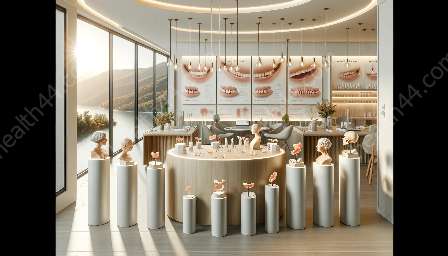Partial dentures play a crucial role in restoring oral function and aesthetics for individuals with missing teeth. The construction of partial dentures involves the use of various materials, each with its own unique properties and benefits. This article explores the different materials commonly employed in the fabrication of partial dentures, including flexible, acrylic, and metal-based options.
Flexible Partial Denture Materials
Flexible partial dentures are crafted from a thermoplastic material that provides both strength and flexibility. The most commonly used material for flexible partial dentures is nylon. This type of material offers several advantages, including:
- Comfort: Flexible partial dentures are lightweight and adapt well to the natural contours of the mouth, providing enhanced comfort for the wearer.
- Durability: Nylon-based dentures are highly durable, making them suitable for long-term use.
- Aesthetics: The flexibility of the material allows for a natural-looking restoration, blending seamlessly with the remaining teeth and gums.
- Ease of Adjustment: Flexible partial dentures can be adjusted easily if necessary, providing a convenient option for patients.
Acrylic Partial Denture Materials
Acrylic is a type of plastic material that is commonly used in the construction of partial dentures. These dentures are usually less expensive than flexible or metal-based options and offer the following benefits:
- Cost-Effectiveness: Acrylic dentures are a more budget-friendly option for individuals in need of partial tooth replacement.
- Ease of Modification: These dentures can be adjusted and modified relatively easily to accommodate changes in the oral cavity or to enhance comfort.
- Lightweight: Acrylic partial dentures are lightweight, making them comfortable to wear for extended periods.
- Esthetic Appeal: Acrylic materials can be color-matched to the natural gum tissue, enhancing the overall aesthetics of the restoration.
Metal-Based Partial Denture Materials
Metal-based partial dentures are typically constructed using a combination of metal alloys, such as cobalt-chromium or titanium. These materials offer the following advantages:
- Strength and Durability: Metal-based dentures are extremely sturdy and can withstand the forces of chewing and biting, providing long-lasting functionality.
- Thin and Lightweight: The use of metal alloys allows for the creation of thin and lightweight denture frameworks, minimizing bulkiness and discomfort.
- Precision Fit: Metal frameworks can be custom-fabricated to provide a precise fit, ensuring optimal comfort and stability within the oral cavity.
- Biocompatibility: Metal alloys used in partial dentures are biocompatible and well-tolerated by the oral tissues, reducing the risk of allergic reactions or irritation.
Conclusion
The choice of material for constructing partial dentures depends on various factors, including the patient's specific needs, budget, and aesthetic preferences. By understanding the features and benefits of flexible, acrylic, and metal-based options, individuals can make informed decisions about the most suitable material for their partial dentures.


